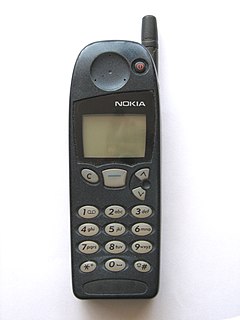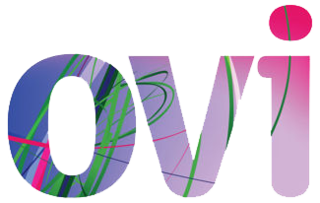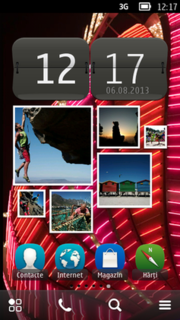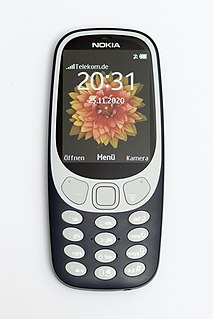Related Research Articles

Nokia Corporation is a Finnish multinational telecommunications, information technology, and consumer electronics company, established in 1865. Nokia's main headquarters are in Espoo, Finland, in the greater Helsinki metropolitan area, but the company's actual roots are in the Tampere region of Pirkanmaa. In 2020, Nokia employed approximately 92,000 people across over 100 countries, did business in more than 130 countries, and reported annual revenues of around €23 billion. Nokia is a public limited company listed on the Helsinki Stock Exchange and New York Stock Exchange. It is the world's 415th-largest company measured by 2016 revenues according to the Fortune Global 500, having peaked at 85th place in 2009. It is a component of the Euro Stoxx 50 stock market index.
Adaptive Multi-Rate Wideband (AMR-WB) is a patented wideband speech audio coding standard developed based on Adaptive Multi-Rate encoding, using a similar methodology to algebraic code-excited linear prediction (ACELP). AMR-WB provides improved speech quality due to a wider speech bandwidth of 50–7000 Hz compared to narrowband speech coders which in general are optimized for POTS wireline quality of 300–3400 Hz. AMR-WB was developed by Nokia and VoiceAge and it was first specified by 3GPP.
Push email is an email system that provides an always-on capability, in which new email is actively transferred (pushed) as it arrives by the mail delivery agent (MDA) to the mail user agent (MUA), also called the email client. Email clients include smartphones and, less strictly, IMAP personal computer mail applications.

The Nokia 7710 is a smartphone developed by Nokia and announced on 2 November 2004. It was the first Nokia device with a touchscreen, and first Nokia branded device with 2:1 aspect ratio display. The 7710 is based on the Nokia 7700 which was never released. It is Nokia's only smartphone to run the Series 90 interface atop Symbian OS v7.0s.

The Nokia 5110 is a GSM mobile phone that was introduced by Nokia on 12 April 1998.
Mobile VoIP or simply mVoIP is an extension of mobility to a Voice over IP network. Two types of communication are generally supported: cordless/DECT/PCS protocols for short range or campus communications where all base stations are linked into the same LAN, and wider area communications using 3G/4G protocols.

Alcatel–Lucent S.A. was a French–American global telecommunications equipment company, headquartered in Boulogne-Billancourt, France. It was formed in 2006 by the merger of France-based Alcatel and U.S.-based Lucent, the latter being a successor of AT&T's Western Electric and Bell Labs.

Ovi by Nokia was the brand for Nokia's Internet services. The Ovi services could be used from a mobile device, computer or via the web. Nokia focused on five key service areas: Games, Maps, Media, Messaging and Music. Nokia's aim with Ovi was to include third party developers, such as operators and third-party services like Yahoo's Flickr photo site. With the announcement of Ovi Maps Player API, Nokia started to evolve their services into a platform, enabling third parties to make use of Nokia's Ovi services.

The Nokia N810 Internet tablet is an Internet appliance from Nokia, announced on 17 October 2007 at the Web 2.0 Summit in San Francisco. Despite Nokia's strong association with cellular products, the N810, like preceding tablets produced by Nokia, was not a phone, but instead allowed the user to browse the Internet and communicate using Wi-Fi networks or with a mobile phone via Bluetooth. It built on the hardware and software of the Nokia N800 with some features added and some removed.

The Nokia 2110 is a cellular phone made by the Finnish telecommunications firm Nokia, first announced in February 1993. It is the first Nokia phone with the famous Nokia tune ringtone. The phone can send and receive SMS messages; and lists ten dialed calls, ten received calls and ten missed calls. At the time of the phone's release, it was smaller than others of its price and had a bigger display, so it became very popular. It also features a "revolutionary" new user interface featuring with two dynamic softkeys, which would later lead to the development of the Navi-key on its successor, the Nokia 6110, as well as the Series 20 interface.

Windows Phone (WP) is a discontinued family of mobile operating systems developed by Microsoft for smartphones as the replacement successor to Windows Mobile and Zune. Windows Phone featured a new user interface derived from the Metro design language. Unlike Windows Mobile, it was primarily aimed at the consumer market rather than the enterprise market.
Casey Dunmore is an American musician, composer, producer and recording artist. He is the Music Producer also known as Schpilkas, based in Los Angeles, California. Dunmore is known for versatile styles ranging from Urban Electronic, Jazz, Rock, Psychedelic, Indie and Classical music, both on albums as well as television and film soundtracks.
The Nokia 6650 fold is a Nokia smartphone announced in March 2008, running Symbian OS. It is a Hex-band unit using GSM 850, 900, 1,800, and 1,900 MHz networks and UMTS 850 and 2,100 Mhz networks. Also noted as a quad-band clamshell 3G smartphone, it was released in June 2008. It was sold through AT&T Mobility in the U.S. It is AT&T's replacement for the S60-powered N75. It was manufactured in three colors, metallic silver, black, and red. It was never a global model, and therefore it was sold exclusively for T-mobile networks in Europe. Models were RM-324 for North America and RM-400 for Europe.

The Nokia N900 is a smartphone made by Nokia. It supersedes the Nokia N810. Its default operating system, Maemo 5, is a Linux-based OS originally developed for the Nokia 770 Internet Tablet. It is the first Nokia device based upon the Texas Instruments OMAP3 microprocessor with the ARM Cortex-A8 core. Unlike the three Nokia Internet tablets preceding it, the Nokia N900 is the first Maemo device to include phone functionality.

Symbian is a discontinued mobile operating system (OS) and computing platform designed for smartphones. Symbian was originally developed as a proprietary software OS for PDAs in 1998 by the Symbian Ltd. consortium. Symbian OS is a descendant of Psion's EPOC, and was released exclusively on ARM processors, although an unreleased x86 port existed. Symbian was used by many major mobile phone brands, like Samsung, Motorola, Sony Ericsson, and above all by Nokia. It was also prevalent in Japan by brands including Fujitsu, Sharp and Mitsubishi. As a pioneer that established the smartphone industry, it was the most popular smartphone OS on a worldwide average until the end of 2010, at a time when smartphones were in limited use, when it was overtaken by iOS and Android. It was notably less popular in North America.

MTV Music is a British pay television channel operated by Paramount Networks UK & Australia. The brand was first launched in the UK and Ireland before launching in Australia, New Zealand, Italy, the Netherlands and Poland. Unlike other MTV Music channels, This channel offers subtitles on selected programmes.
Nokia's strategic nomenclature can be traced back in 2005 when the Nseries line was launched, offering devices with flagship specifications and premium hardware at various price points. These devices were considered the "bread and butter" of the company and were often positioned to showcase their latest technologies. Thanks to the newfound consumer and enterprise interest in smartphones at the time, the company introduced four additional collections to diversify their product portfolio and meet demands in most market segments. These new phone series were named Eseries, targeting small business and enterprise customers; Xseries, providing consumer-grade multimedia-focused devices; Cseries, which Nokia used to target both the low-end and mid-range market segments; and Tseries, for devices exclusive to the Chinese market.
Enhanced Voice Services (EVS) is a superwideband speech audio coding standard that was developed for VoLTE. It offers up to 20 kHz audio bandwidth and has high robustness to delay jitter and packet losses due to its channel aware coding and improved packet loss concealment. It has been developed in 3GPP and is described in 3GPP TS 26.441. The application areas of EVS consist of improved telephony and teleconferencing, audiovisual conferencing services, and streaming audio. Source code of both decoder and encoder in ANSI C is available as 3GPP TS 26.442 and is being updated regularly. Samsung uses the term HD+ when doing a call using EVS.

The Nokia 3310 (2017) is a Nokia-branded feature phone developed by HMD Global. It was announced on 26 February 2017 at Mobile World Congress (MWC) 2017 in Barcelona as a revival of the original Nokia 3310 that was produced from the early 2000s. An improved model with 3G support was released on 29 October 2017.
References
- ↑ "Koniec MTV Mobile. Migracja do T-Mobile na kartę". Media2.pl (in Polish). Retrieved 2022-06-02.